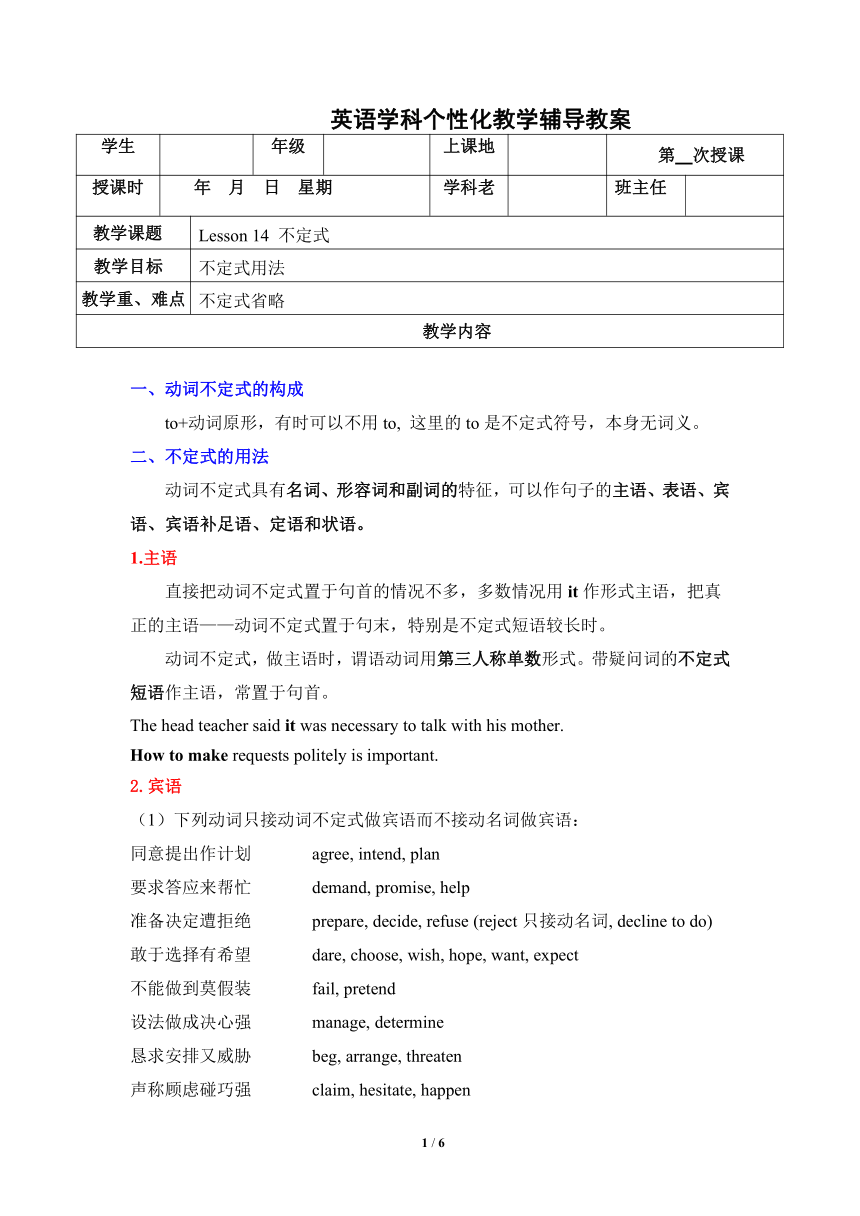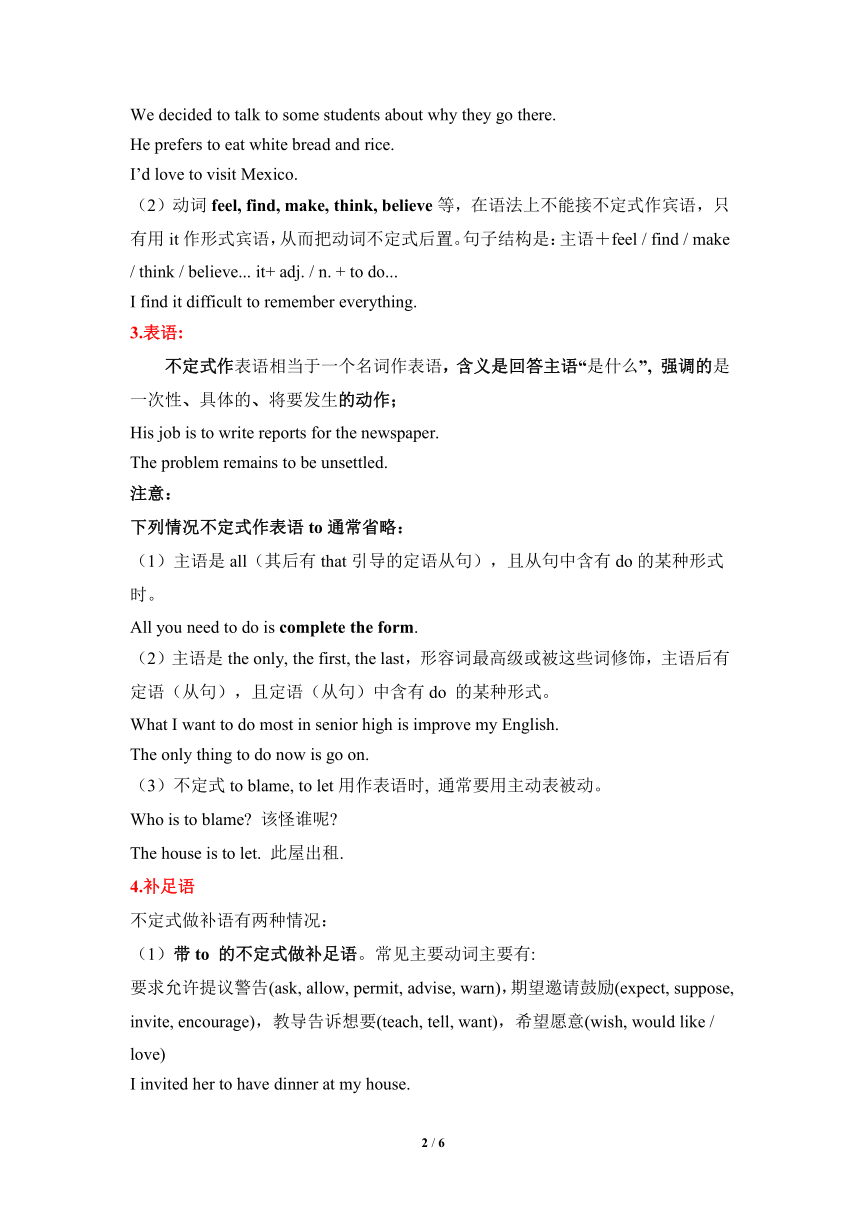2022年中考英语语法专题-第14讲 不定式
文档属性
| 名称 | 2022年中考英语语法专题-第14讲 不定式 |  | |
| 格式 | docx | ||
| 文件大小 | 27.9KB | ||
| 资源类型 | 教案 | ||
| 版本资源 | 通用版 | ||
| 科目 | 英语 | ||
| 更新时间 | 2022-01-18 13:00:39 | ||
图片预览



文档简介
英语学科个性化教学辅导教案
学生 年级 上课地点 第 次授课
授课时间 年 月 日 星期 学科老师 班主任
教学课题 Lesson 14 不定式
教学目标 不定式用法
教学重、难点 不定式省略
教学内容
一、动词不定式的构成
to+动词原形,有时可以不用to, 这里的to是不定式符号,本身无词义。
二、不定式的用法
动词不定式具有名词、形容词和副词的特征,可以作句子的主语、表语、宾语、宾语补足语、定语和状语。
1.主语
直接把动词不定式置于句首的情况不多,多数情况用it作形式主语,把真正的主语——动词不定式置于句末,特别是不定式短语较长时。
动词不定式,做主语时,谓语动词用第三人称单数形式。带疑问词的不定式短语作主语,常置于句首。
The head teacher said it was necessary to talk with his mother.
How to make requests politely is important.
2.宾语
(1)下列动词只接动词不定式做宾语而不接动名词做宾语:
同意提出作计划 agree, intend, plan
要求答应来帮忙 demand, promise, help
准备决定遭拒绝 prepare, decide, refuse (reject只接动名词, decline to do)
敢于选择有希望 dare, choose, wish, hope, want, expect
不能做到莫假装 fail, pretend
设法做成决心强 manage, determine
恳求安排又威胁 beg, arrange, threaten
声称顾虑碰巧强 claim, hesitate, happen
We decided to talk to some students about why they go there.
He prefers to eat white bread and rice.
I’d love to visit Mexico.
(2)动词feel, find, make, think, believe等,在语法上不能接不定式作宾语,只有用it作形式宾语,从而把动词不定式后置。句子结构是:主语+feel / find / make / think / believe... it+ adj. / n. + to do...
I find it difficult to remember everything.
3.表语:
不定式作表语相当于一个名词作表语,含义是回答主语“是什么”, 强调的是一次性、具体的、将要发生的动作;
His job is to write reports for the newspaper.
The problem remains to be unsettled.
注意:
下列情况不定式作表语to通常省略:
(1)主语是all(其后有that引导的定语从句),且从句中含有do的某种形式时。
All you need to do is complete the form.
(2)主语是the only, the first, the last,形容词最高级或被这些词修饰,主语后有定语(从句),且定语(从句)中含有do 的某种形式。
What I want to do most in senior high is improve my English.
The only thing to do now is go on.
(3)不定式to blame, to let用作表语时, 通常要用主动表被动。
Who is to blame 该怪谁呢
The house is to let. 此屋出租.
4.补足语
不定式做补语有两种情况:
(1)带to 的不定式做补足语。常见主要动词主要有:
要求允许提议警告(ask, allow, permit, advise, warn),期望邀请鼓励(expect, suppose, invite, encourage),教导告诉想要(teach, tell, want),希望愿意(wish, would like / love)
I invited her to have dinner at my house.
Teenagers should be allowed to choose their own clothes.
(3)不带to的不定式做补语。动词不定式作补语,在主动语态句里不带to, 被动语态句里带to时多数动词是感官动词和使役动词,包括四“看”: look at, observe, see, watch,三“让”: have, let, make,二“听”: hear, listen to,一“感觉”: feel,一“注意”: notice
This picture makes me feel tense.
Of course we want to see Liu Yu achieve his dreams.
(3)help后接动词不定式作补语,to可带可不带。一般说来,带to表间接帮助,不带to表直接帮助。在被动语态句里,或者用不定式的否定式作补语时要带to。
They can help you to compare two different products so that you can buy the one you really need.
Using e-mail English helps you write quickly.
(4)be said, be sure, happen, seem等后面可以接带to的动词不定式作主语的补语。
He doesn’t seem to have many friends.
Be sure not to miss them if they come to a city near you.
5.定语
不定式做定语,必须位于被修饰的名词或者代词后面,以下几种情况常使用不定式做定语:
(1)表示将来的动作,根据需要不定式可用于被动或者主动形式。
I borrow some books to read during my holiday.
The car to be bought is for his sister.
(2)序数词,形容词最高级,the last, the only等后或被这些词修饰的名词或者代词后。
He is the best man to do the job.
(3)There be句型中做主语的名词或者代词后。此时动词不定式表示一般情况或者将要发生的动作。
There are lots of problems to solve.
(4)被修饰词是表示抽象名词时,常用不定式做后置定语,且不定式常用主动形式。不定式与被修饰的名词之间是同位关系,不定式说明被修饰的名词的内容。常见此类名词有ability, chance, idea, fact, evidence, attempt, belief, way, reason, opportunity, time等。
I want to have a chance to further my study abroad.
注意:
①不定式中的动词为不及物动词或所修饰名词为不定式动作的工具, 不定式后面要用必要的介词。
He found a good house to live in. 他找到了一个居住的好房子。
The child has nothing to worry about. 这个孩子无忧无虑。
I have no pen to write with. 我没有笔写字。
②如果不定式修饰time, place, way可以省略介词。
He has no place to live. 他无处安身。
This is the best way to work out this problem.这是解决这个问题的最好办法。
③如果不定式所修饰名词是不定式动作承受者,不定式可用主动式也可用被动式, 但意义不同:
Have you got anything to send 你要送什么东西吗
Have you got anything to be sent 你有什么东西需要送吗
6.状语
(1)不定式做目的状语,其逻辑主语通常是句子主语。强调动词不定式所表示的目的时常用in order to / so as to,其中so as to不用与句首。
A group of young people got together to discuss this question.
In order to help him, we would do everything we can.
(2)不定式作结果状语时多表示出乎意料的结果,其逻辑主语通常是句子的主语。做结果状语的不定式通常用一般式,为了表示强调可在不定式前加上only; 不定式做状语时,也常用于so…as to, such …as to…, enough to…, too…to, only to…等结构中。
I rushed to the station, only to find the train had already gone.
He was so late as to miss half of the lecture.
She is such a good teacher as to be respected by all her students.
The house is big enough to hold 200 people.
(3)不定式与情感类形容词词连用时,大多表示原因,用来做原因状语,此类形容词有:happy, kind, surprised, shocked, glad, delighted, disappointed 。
I was very sad to hear the news.
(4)不定式也可跟在一些做表语的形容词easy, difficult, pleasant, good, fit, comfortable等后面做状语。在此用法是,动词不定式动作和句子的主语构成逻辑上的动宾关系,用主动表示被动,如不定式动词为不及物动词要加上相应介词。
This book is difficult to understand.
The picture is pleasant to look at.
7. 独立动词不定式多用作插入语,表示说话人的心理状态或对事情的看法。
to be frank, to be honest, to begin with
I’d like to stay healthy, but to be honest, I only eat food that tastes good.
To begin with, she spoke too quickly, and I couldn’t understand every word.
8.动词不定式的复合结构
动词不定式的复合结构是“for / of sb. to do sth.”,for / of引出不定式动作的逻辑主语。
不定式复合结构的介词用for还是of,主要决定于前面形容词的性质。一般说来,of前面的形容词是careful, clever, foolish, good, kind, nice, wise, right, wrong等,既说明人的特性,又说明不定式动作的特性。for前面的形容词是dangerous, difficult, easy, hard, heavy, important, interesting, necessary等,一般说明不定式动作的特性,不说明人的特性。前面如果是名词用for。
It’s also probably a good idea for parents to allow teenagers to study in groups during the evening.
It’s kind of you to help me.
9. 带疑问词的不定式短语
动词不定式前面可以带疑问代词what, which, who或疑问副词how, when, where, why等。这种结构起名词的作用,在句子里用作宾语、主语、表语等,或者单独使用。要注意的是,why后面的不定式不带to。
I don’t know what to try next. (作宾语)
Where to go is not decided yet.(作主语)
注意:
单独使用时相当于一个特殊疑问句。
What to do next (=What will we / you do next )
Why go there (=Why do we / you go there )
10.动词不定式的否定式
不定式的否定式是not / never to do...,不带to的不定式的否定式是not / never do...
Sometimes they have disagreements, and decide not to talk to each other.
His parents tell him never to drive after drinking.
11.不定式的一般式,进行式,完成式及被动语态的基本用法
(1)动词不定式的一般式所表示动作与句中谓语动作之后发生,或者不强调先后顺序。
He helped me to clean the classroom.
He hoped to visit Beijing one day.
(2)动词不定式完成式表示动作发生在谓语动作之前。
I’m sorry to have broken your cup.
(3)动词不定式进行时表示动作和谓语动词动作同时发生。
It happened to be raining when I got to Beijing.
(4)动词不定式被动语态,表示动作与他的逻辑主语之间有种被动关系。
I’m glad to be asked to speak here.
12.常用不定式句型
It’s time to do sth. = It time for sth.
There is no time left for sb to do sth.
It takes sb. + time to do sth. 2 / 2
学生 年级 上课地点 第 次授课
授课时间 年 月 日 星期 学科老师 班主任
教学课题 Lesson 14 不定式
教学目标 不定式用法
教学重、难点 不定式省略
教学内容
一、动词不定式的构成
to+动词原形,有时可以不用to, 这里的to是不定式符号,本身无词义。
二、不定式的用法
动词不定式具有名词、形容词和副词的特征,可以作句子的主语、表语、宾语、宾语补足语、定语和状语。
1.主语
直接把动词不定式置于句首的情况不多,多数情况用it作形式主语,把真正的主语——动词不定式置于句末,特别是不定式短语较长时。
动词不定式,做主语时,谓语动词用第三人称单数形式。带疑问词的不定式短语作主语,常置于句首。
The head teacher said it was necessary to talk with his mother.
How to make requests politely is important.
2.宾语
(1)下列动词只接动词不定式做宾语而不接动名词做宾语:
同意提出作计划 agree, intend, plan
要求答应来帮忙 demand, promise, help
准备决定遭拒绝 prepare, decide, refuse (reject只接动名词, decline to do)
敢于选择有希望 dare, choose, wish, hope, want, expect
不能做到莫假装 fail, pretend
设法做成决心强 manage, determine
恳求安排又威胁 beg, arrange, threaten
声称顾虑碰巧强 claim, hesitate, happen
We decided to talk to some students about why they go there.
He prefers to eat white bread and rice.
I’d love to visit Mexico.
(2)动词feel, find, make, think, believe等,在语法上不能接不定式作宾语,只有用it作形式宾语,从而把动词不定式后置。句子结构是:主语+feel / find / make / think / believe... it+ adj. / n. + to do...
I find it difficult to remember everything.
3.表语:
不定式作表语相当于一个名词作表语,含义是回答主语“是什么”, 强调的是一次性、具体的、将要发生的动作;
His job is to write reports for the newspaper.
The problem remains to be unsettled.
注意:
下列情况不定式作表语to通常省略:
(1)主语是all(其后有that引导的定语从句),且从句中含有do的某种形式时。
All you need to do is complete the form.
(2)主语是the only, the first, the last,形容词最高级或被这些词修饰,主语后有定语(从句),且定语(从句)中含有do 的某种形式。
What I want to do most in senior high is improve my English.
The only thing to do now is go on.
(3)不定式to blame, to let用作表语时, 通常要用主动表被动。
Who is to blame 该怪谁呢
The house is to let. 此屋出租.
4.补足语
不定式做补语有两种情况:
(1)带to 的不定式做补足语。常见主要动词主要有:
要求允许提议警告(ask, allow, permit, advise, warn),期望邀请鼓励(expect, suppose, invite, encourage),教导告诉想要(teach, tell, want),希望愿意(wish, would like / love)
I invited her to have dinner at my house.
Teenagers should be allowed to choose their own clothes.
(3)不带to的不定式做补语。动词不定式作补语,在主动语态句里不带to, 被动语态句里带to时多数动词是感官动词和使役动词,包括四“看”: look at, observe, see, watch,三“让”: have, let, make,二“听”: hear, listen to,一“感觉”: feel,一“注意”: notice
This picture makes me feel tense.
Of course we want to see Liu Yu achieve his dreams.
(3)help后接动词不定式作补语,to可带可不带。一般说来,带to表间接帮助,不带to表直接帮助。在被动语态句里,或者用不定式的否定式作补语时要带to。
They can help you to compare two different products so that you can buy the one you really need.
Using e-mail English helps you write quickly.
(4)be said, be sure, happen, seem等后面可以接带to的动词不定式作主语的补语。
He doesn’t seem to have many friends.
Be sure not to miss them if they come to a city near you.
5.定语
不定式做定语,必须位于被修饰的名词或者代词后面,以下几种情况常使用不定式做定语:
(1)表示将来的动作,根据需要不定式可用于被动或者主动形式。
I borrow some books to read during my holiday.
The car to be bought is for his sister.
(2)序数词,形容词最高级,the last, the only等后或被这些词修饰的名词或者代词后。
He is the best man to do the job.
(3)There be句型中做主语的名词或者代词后。此时动词不定式表示一般情况或者将要发生的动作。
There are lots of problems to solve.
(4)被修饰词是表示抽象名词时,常用不定式做后置定语,且不定式常用主动形式。不定式与被修饰的名词之间是同位关系,不定式说明被修饰的名词的内容。常见此类名词有ability, chance, idea, fact, evidence, attempt, belief, way, reason, opportunity, time等。
I want to have a chance to further my study abroad.
注意:
①不定式中的动词为不及物动词或所修饰名词为不定式动作的工具, 不定式后面要用必要的介词。
He found a good house to live in. 他找到了一个居住的好房子。
The child has nothing to worry about. 这个孩子无忧无虑。
I have no pen to write with. 我没有笔写字。
②如果不定式修饰time, place, way可以省略介词。
He has no place to live. 他无处安身。
This is the best way to work out this problem.这是解决这个问题的最好办法。
③如果不定式所修饰名词是不定式动作承受者,不定式可用主动式也可用被动式, 但意义不同:
Have you got anything to send 你要送什么东西吗
Have you got anything to be sent 你有什么东西需要送吗
6.状语
(1)不定式做目的状语,其逻辑主语通常是句子主语。强调动词不定式所表示的目的时常用in order to / so as to,其中so as to不用与句首。
A group of young people got together to discuss this question.
In order to help him, we would do everything we can.
(2)不定式作结果状语时多表示出乎意料的结果,其逻辑主语通常是句子的主语。做结果状语的不定式通常用一般式,为了表示强调可在不定式前加上only; 不定式做状语时,也常用于so…as to, such …as to…, enough to…, too…to, only to…等结构中。
I rushed to the station, only to find the train had already gone.
He was so late as to miss half of the lecture.
She is such a good teacher as to be respected by all her students.
The house is big enough to hold 200 people.
(3)不定式与情感类形容词词连用时,大多表示原因,用来做原因状语,此类形容词有:happy, kind, surprised, shocked, glad, delighted, disappointed 。
I was very sad to hear the news.
(4)不定式也可跟在一些做表语的形容词easy, difficult, pleasant, good, fit, comfortable等后面做状语。在此用法是,动词不定式动作和句子的主语构成逻辑上的动宾关系,用主动表示被动,如不定式动词为不及物动词要加上相应介词。
This book is difficult to understand.
The picture is pleasant to look at.
7. 独立动词不定式多用作插入语,表示说话人的心理状态或对事情的看法。
to be frank, to be honest, to begin with
I’d like to stay healthy, but to be honest, I only eat food that tastes good.
To begin with, she spoke too quickly, and I couldn’t understand every word.
8.动词不定式的复合结构
动词不定式的复合结构是“for / of sb. to do sth.”,for / of引出不定式动作的逻辑主语。
不定式复合结构的介词用for还是of,主要决定于前面形容词的性质。一般说来,of前面的形容词是careful, clever, foolish, good, kind, nice, wise, right, wrong等,既说明人的特性,又说明不定式动作的特性。for前面的形容词是dangerous, difficult, easy, hard, heavy, important, interesting, necessary等,一般说明不定式动作的特性,不说明人的特性。前面如果是名词用for。
It’s also probably a good idea for parents to allow teenagers to study in groups during the evening.
It’s kind of you to help me.
9. 带疑问词的不定式短语
动词不定式前面可以带疑问代词what, which, who或疑问副词how, when, where, why等。这种结构起名词的作用,在句子里用作宾语、主语、表语等,或者单独使用。要注意的是,why后面的不定式不带to。
I don’t know what to try next. (作宾语)
Where to go is not decided yet.(作主语)
注意:
单独使用时相当于一个特殊疑问句。
What to do next (=What will we / you do next )
Why go there (=Why do we / you go there )
10.动词不定式的否定式
不定式的否定式是not / never to do...,不带to的不定式的否定式是not / never do...
Sometimes they have disagreements, and decide not to talk to each other.
His parents tell him never to drive after drinking.
11.不定式的一般式,进行式,完成式及被动语态的基本用法
(1)动词不定式的一般式所表示动作与句中谓语动作之后发生,或者不强调先后顺序。
He helped me to clean the classroom.
He hoped to visit Beijing one day.
(2)动词不定式完成式表示动作发生在谓语动作之前。
I’m sorry to have broken your cup.
(3)动词不定式进行时表示动作和谓语动词动作同时发生。
It happened to be raining when I got to Beijing.
(4)动词不定式被动语态,表示动作与他的逻辑主语之间有种被动关系。
I’m glad to be asked to speak here.
12.常用不定式句型
It’s time to do sth. = It time for sth.
There is no time left for sb to do sth.
It takes sb. + time to do sth. 2 / 2
同课章节目录
- 词法
- 名词
- 动词和动词短语
- 动词语态
- 动词时态
- 助动词和情态动词
- 非谓语动词
- 冠词
- 代词
- 数词和量词
- 形容词副词及其比较等级
- 介词和介词短语
- 连词和感叹词
- 构词法
- 相似、相近词比较
- 句法
- 陈述句
- 一般疑问句和否定疑问句
- 特殊疑问句及选择疑问句
- 反意疑问句
- 存在句(There be句型)
- 宾语从句
- 定语从句
- 状语从句
- 主谓一致问题
- 简单句
- 并列句
- 复合句
- 主谓一致
- 主、表语从句
- 名词性从句
- 直接引语和间接引语
- 虚拟语气
- 感叹句
- 强调句
- 倒装句
- 祈使句
- 句子的成分
- 句子的分类
- 题型专区
- 单项选择部分
- 易错题
- 完形填空
- 阅读理解
- 词汇练习
- 听说训练
- 句型转换
- 补全对话
- 短文改错
- 翻译
- 书面表达
- 任务型阅读
- 语法填空
- 其他资料
